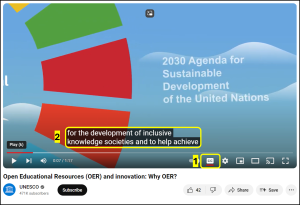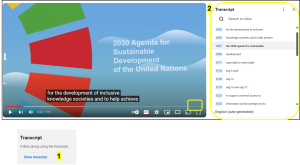Accessibility in Your OER
5.6 Accessible Multimedia in Pressbooks
Theresa Huff
Accessibility Standard – Multimedia
Transcripts are provided for audio recordings, and videos are captioned and include audible contextual visual descriptions.
What are multimedia?
The term multimedia refers to a variety of ways, or media, used to communicate information, such as videos, audio, animations, and slideshows.
File types used: MP3, MP4, PPT
Note: This guidance focuses on audio and video multimedia, but any tools you choose to use, you will want to ensure are accessible, too. For more on this, see Accessibility, UDL, and Your Tools.
For whom are you doing this?
This work supports students who:
- Are deaf or hard of hearing
- Are blind or have low vision
- Have a form of cognitive disability
- Are in a location where they cannot play or hear audio
- Are not native-English speakers and need written-word formats to support understanding
How does that work? – Transcripts, Captions, and Audio Descriptions
Transcripts and Captions
Transcripts provide the full transcription of audio content in a media file. They are often key word searchable and offer an alternative to watching a video in order to receive content. Media captions provide a running transcription of audio content that is synched up to an audio or video file.
In UNESCO’s video about OER below, users can access a transcript and turn on media captions.

The captions can be turned on by selecting CC below the video [1], allowing viewers to read all speech content and relevant non-speech content of the audio which is synchronized with the video [2].

When viewed in YouTube, below the video, UNESCO has provided a Transcript. When Show Transcript is selected [1], the transcript of the YouTube video displays alongside the video [2], allowing viewers to read all speech content and relevant non-speech content in the video.
Audio Descriptions
Audio Descriptions provide context for visual elements in media that may be left out of a transcript or caption. In the following video by My Vision, the narrator has incorporated audio descriptions into the video by 1) describing what the people are doing in the video rather than assuming the user can view it for themselves and 2) adding in audio descriptions of unspoken but important parts of the video.
Why is this important?
Incorporating media into your textbook ensures that students aren’t bogged down in heavy blocks of endless text. This is a key principle for Universal Design for Learning. Multiple means of representation ensures that students can listen to audio or access video files and images or analyze graphs and charts in order to engage in course content.
Meaningful audio, video, and graphics support attention and focus in ways that text by itself fails to do. However, if audio isn’t accurately captioned, students who are Deaf or hard of hearing won’t be able to access this content. English language learners will miss key information. Students who are studying with sound off while on public transit won’t be able to accurately follow along. Accurate media captions ensure that students have an equitable opportunity to engage.
In addition to media captions, an accurate transcript is a key step in tracking information and synthesizing complex ideas. Transcripts are excellent for students who can read more efficiently than they process auditory information. Transcripts are also important for students who want to accurately cite or quote something they learned from engaging with the multimedia.
If the captions and transcript do not contain contextual descriptions, audio descriptions help those who are blind or low vision to better understand the visual context.
What do you need to do?
Accessibility Checklist – Multimedia
o All audio content includes a transcript. The transcript includes all speech content and relevant descriptions of non-speech audio and speaker names/headings where necessary.
o Videos have captions of all speech content and relevant non-speech content that has been edited by a human for accuracy.
o All videos with contextual visuals (graphs, charts, etc.) are described audibly in the video.
When to provide Captions, Transcripts, or Audio Descriptions
Determining what you need to do to make your media accessible, starts with understanding what is required for different types of multimedia. Consider the following questions:
- Does your multimedia resource include audio that is synchronized with a video presentation? If so, you should:
- provide captions of all speech content and relevant non-speech content in the resource
- Does your multimedia resource include audio narration or instructions? If so, you should:
- provide a complete transcript of all speech content and relevant non-speech content in the resource
- Does your multimedia resource include contextual visuals (e.g., charts, graphs) that are not addressed in the spoken content? If so, you should:
- provide audio descriptions of relevant visual materials in the resource
What is included in Transcripts, Captions, and Audio Descriptions
Select the arrow next to the accessibility term to learn what each entail and to see examples of each in practice.
Transcripts
Consider what your students would get out of your multimedia resource if they were not able to hear the audio portion, or if they had difficulty understanding the spoken word. A text transcript provides students with equivalent information to the audio content in a multimedia resource.[1]
As you work on developing a text transcript, keep in mind the following recommendations about what to include:
- Speaker’s name
- All speech content. If there is speech that is not relevant, it is usually best to indicate that it has been excluded from the transcript, e.g., “[A & B chatted while slides were loading].”
- Relevant descriptions about the speech. Descriptions that convey emotions and mood are usually provided in brackets, e.g., “Don’t touch that! [shouted].”
- Descriptions of relevant non-speech audio. These are usually provided in brackets, e.g., “[metal pipes crashing to concrete floor].” Background noise that isn’t relevant can be left out.
- Headings and sub-headings. Headings help when they make a transcript more usable or easy to navigate, especially when the transcript is long. When included, put headings in brackets to show they were not part of the original audio, e.g., [Introduction]; [Group Discussion]; [Case Study].
Transcripts and Third-Party Videos
If you are not producing your own video resource but are planning to embed video materials from a third-party source (e.g., YouTube), be aware that not all third-party videos include transcripts. While services like YouTube technically support transcripts, not all of their contributors include them. If you select a video resource that does not already have a transcript, you will need to produce one yourself.
Creating a transcript for a third-party video might infringe on copyright, depending on how the video has been licensed. Before producing a transcript for media materials you did not create, contact the copyright holder of that material for permission to do so. (See information about using YouTube in Pressbooks in the Pressbooks Guide.)
Captions
Captions are the text that is synchronized with the audio in a video presentation. Captions are important when people need to see what’s happening in the video and get the audio information in text at the same time.
The work you put into creating a text transcript for a video resource can be repurposed to provide captions. Keep in mind the following recommendations about what to include in your captions:
- All speech content. If there is speech that is not relevant, it is usually best to indicate that it has been excluded from the captions, e.g., “[A & B chatted while slides were loading].”
- Descriptions of relevant non-speech audio. These are usually provided in brackets, e.g., “[metal pipes crashing to concrete floor]”; “[background music by XXX plays].” Background noise that isn’t relevant can be left out.
Audio Descriptions
Consider what your students would get out of a multimedia resource if they were not able to see embedded visual materials critical for comprehension. Audio descriptions are helpful if visual content (e.g., a chart or map) in a video or presentation provides important context that is not available through the audio alone.[2]
When describing visual elements in your multimedia resources, keep in mind the following recommendations and guidelines:
- When contextual visual content on the screen is not described in the audio itself, you will need to provide an objective audio description of the visual element.
- Whenever possible, avoid creating the need for audio descriptions in the first place by being proactive at the time of recording. If you pay attention to contextual visuals while recording, you may find opportunities to convey the visual content with the accompanying spoken material instead of inserting audio descriptions of the visual content after the fact.
Example 1
To help students fully grasp a concept that you are trying to convey in your video, you have included some contextual visual references (e.g., maps, charts, physical demonstrations of a process). However, you realize, after making the video, that the audio portion does not describe these visuals in enough detail for a blind, low-vision student to be able to access all of the concepts you intended to convey.
In this case, you would need to record an audio description of the visual material that provides enough detail, so the same content is available to all learners.
Example 2
You are recording a video or presentation that includes a chart that tracks coal production in British Columbia, and as part of the presentation you want to focus on specific data in the chart. The narrator or presenter might point to sections on the chart and say:
“As you can see, metallurgical coal projection increased by three million tons over these two years.”
In this case, audio descriptions would be necessary to provide the missing context to students with visual disabilities; these students cannot see the data on the chart that tells visual learners what the production figures are and for what dates. However, if the narrator or presenter instead says:
“This chart illustrates that metallurgical coal production in B.C. increased from 23 million tons in 1999 to 26 million tons in 2001,”
the visual content is conveyed through the audio and no audio description will be necessary.
How to create Transcripts, Captions, and Audio Descriptions
This video from Pope Tech, offers efficient steps and excellent tips for creating transcripts, captions, and if needed, audio descriptions to a YouTube video.
How to Check Your OER for Captions, Transcripts, and Audio Descriptions
Self-Comprehension Check
Licenses and Attributions
“Accessible Multimedia in Pressbooks” by Theresa Huff is adapted from “Multimedia- Accessibility Toolkit – 2nd Edition” by Amanda Coolidge, Sue Doner, Tara Robertson, and Josie Gray for BCcampus, used under a CC BY 4.0 license, “Media Captions and Transcripts – Doing the Work: Diversity, Equity, and Inclusion in Open Educational Resources” by Veronica Vold for Open Oregon Educational Resources, used under a CC BY 4.0 license, and “Improving Accessibility in Course Materials – Online Course Development Basics” by Jeani Young for Trustees of Indiana University, used under a CC BY 4.0 license. “Accessible Multimedia in Pressbooks” is licensed under CC BY 4.0.
